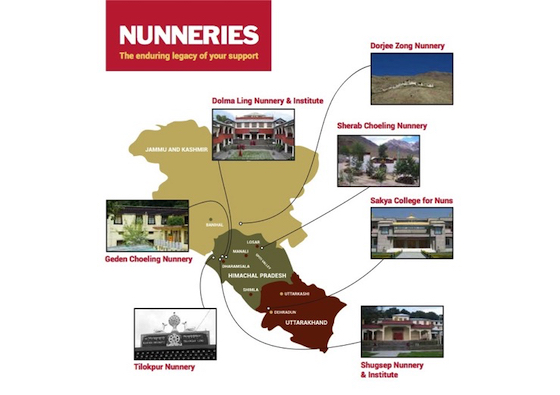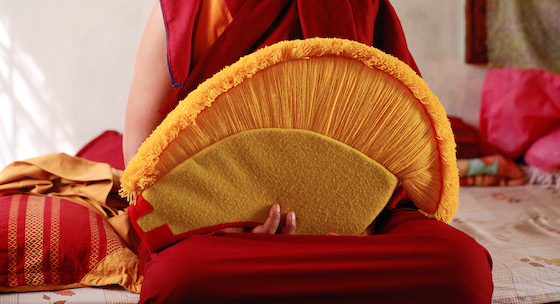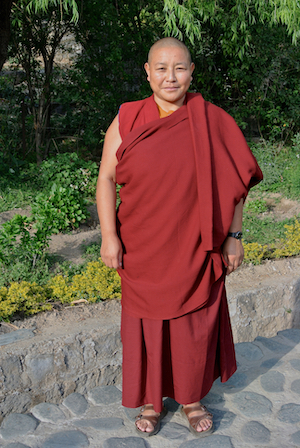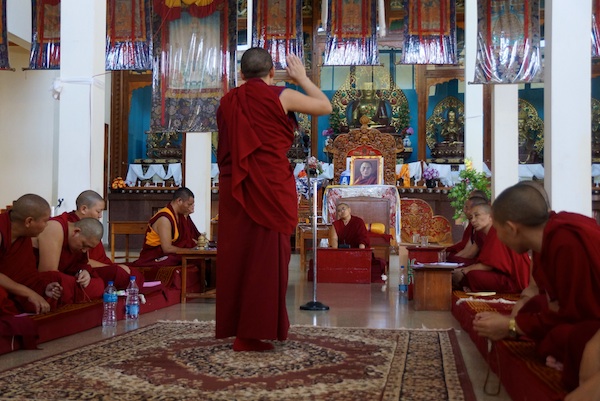We are sometimes asked, “What are the four main schools of Tibetan Buddhism and which nuns do you support?”
The four main schools of Tibetan Buddhism are Nyingma, Kagyu, Sakya, and Gelug.
- Nyingma (founded in 8th century)
- Kagyu (founded in the early 11th century)
- Sakya (founded in 1073)
- Gelug (founded in 1409)
Other religious schools are Bon and Jonang.
The Tibetan Nuns Project supports nuns from all four schools of Tibetan Buddhism. See more details below.
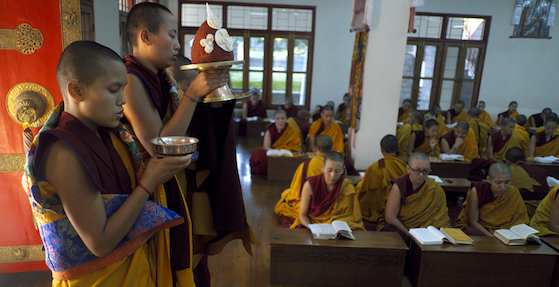
Photo of Tibetan Buddhist nuns courtesy of Brian Harris
The Nyingma School of Tibetan Buddhism
The Nyingma or “ancient” tradition is the oldest of the four schools of Tibetan Buddhism. Often referred to as “the ancient translation school”, it was founded in the eighth century following the first translations of Buddhist scriptures from Sanskrit to Tibetan.
Around 760, the Tibetan king Trisong Detsen invited two Buddhist masters from the Indian subcontinent, Padmasambhava and Shantarakshita, to the “Land of Snows” to bring Buddhism to the Tibetan people. Thus began a massive translation project of all Buddhist texts into the newly created Tibetan language.
The legendary Vajrayana master Padmasambhava, who Tibetans call Guru Rinpoche, is considered the founder of Tibetan Buddhism. He supervised the translation of the tantras (the esoteric teachings of the Buddha) while Shantarakshita, abbot of the great Buddhist Nalanda University, supervised the translation of the sutras (oral teachings of the Buddha).
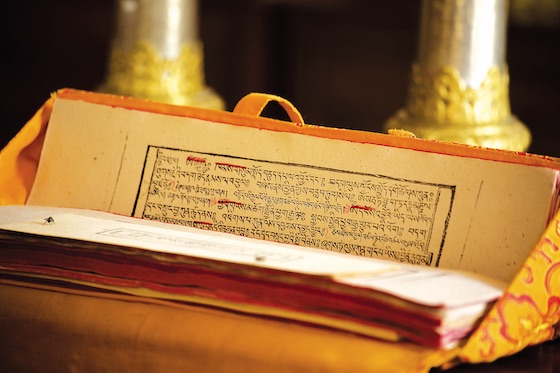
Tibetan block-printed prayers. Photo by Olivier Adam.
Together they founded the first monastery in Tibet, Samye, which became the main center for Buddhist teaching in Tibet for around three centuries.
The Nyingma tradition classifies the Buddhist teachings into nine yanas or vehicles. The first three vehicles are common to all schools of Buddhism, the next three are common to all schools of Tantric Buddhism, and the last three are exclusive to the Nyingma tradition. The highest is known as Dzogchen or the Great Perfection.
Unlike the other schools, the Nyingma traditionally had no centralized authority or a single head of the lineage. However, since the Chinese invasion of Tibet, the Nyingma school has had representatives.
Here is a list of the 8 representatives of the Nyingma school since this practice began in the 1960s:
- Dudjom Rinpoche (c. 1904–1987), served from the 1960s until his death.
- Dilgo Khyentse Rinpoche (c. 1910–1991), served from 1987 until his death.
- Penor (Pema Norbu) Rinpoche (1932–2009) served from 1991 until retirement in 2003.
- Mindrolling Trichen Rinpoche (c. 1930–2008), served from 2003 until his death.
- Trulshik Rinpoche (1923–2011), selected after Chatral Rinpoche declined the position.
- Taklung Tsetrul Rinpoche (1926-2015), appointed head in 2012 and passed away in Bodhgaya in 2015
- Kathok Getse Rinpoche (1954-2018), passed away ten months after being named to a three-year term as the supreme head of the Nyingma school.
- Dzogchen Rinpoche Jigme Losel Wangpo was selected in January 2019 as the eighth head of the Nyingma school of Tibetan Buddhism by the heads of the principal monasteries of the Nyingma tradition.
The Kagyu School of Tibetan Buddhism
The Kagyu school of Tibetan Buddhism gets its name from the Tibetan བཀའ་བརྒྱུད། meaning “oral lineage” or “whispered transmission”. While it traces its origin back to Buddha Shakyamuni, the most important source for the specific practices of the Kagyu order is the great Indian yogi Tilopa (988-1069).
The practices were passed orally from teacher to disciple through a series of great masters. The transmission lineage of the “Five Founding Masters” of the Kagyu school of Tibetan Buddhism is as follows:
- Tilopa (988-1069), the Indian yogi who experienced the original transmission of the Mahamudra
- Naropa (1016–1100), the Indian scholar-yogi who perfected the methods of accelerated enlightenment described in his Six Yogas of Naropa
- Marpa (1012–1097), the first Tibetan in the lineage, known as the great translator for his work translating the Vajrayana and Mahamudra texts into Old Tibetan
- Milarepa (1052–1135), the poet and greatest yogi of Tibet who overcame Marpa’s reluctance to teach and attained enlightenment in a single lifetime
- Gampopa (1079–1153), Milarepa’s most important student, who integrated Atisha’s Kadam teachings and Tilopa’s Mahamudra teaching to establish the Kagyu lineage.
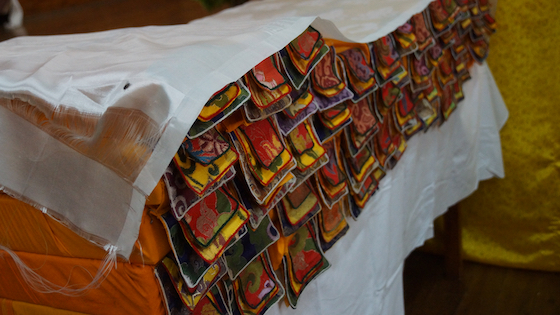
The Kangyur, the words of the Buddha. Photo by the Dolma Ling Nuns’ Media Team
The Kagyu lineage practices have a special focus on the tantric teachings of the Vajrayana and Mahamudra teachings. Some of the most distinguished works of the Kagyu Tibetan masters are the works of Marpa, the Vajra Songs of Milarepa, the Collected Works of Gampopa, of the Karmapas, of Drikhung Kyöppa Jigten Sumgön, and of Drukpa Kunkhyen Pema Karpo.
In the Kagyu school, there are a large number of independent sub-schools and lineages.
The Sakya School of Tibetan Buddhism
The Sakya school of Tibetan Buddhism dates to the 11th century. The name comes from the Tibetan ས་སྐྱ་ meaning “pale earth” describing the grey landscape near Shigatse, Tibet where the Sakya Monastery – the first monastery of this tradition and the seat of the Sakya School – was built in 1073.
The Sakya tradition developed during the second period of translation of Buddhist scripture from Sanskrit into Tibetan and was founded by Drogmi, a famous scholar and translator who had studied under Naropa and other great Indian masters.
The heart of the Sakya lineage teaching and practice is Lamdre, The Path and Its Fruit, a comprehensive and structured meditation path in Tibetan Vajrayana Buddhism.
The head of Sakya School is the “Sakya Trizin” (“the holder of the Sakya throne”), who is always drawn from the male line of the Khön family. It was previously a lifetime position that rotated between the two branches of that lineage, the Phuntsok Potrang and the Dolma Potrang. The previous head of the Sakya School, His Holiness Ngawang Kunga Thekchen Palbar Samphel Ganggi Gyalpo, was born in 1945 in Tsedong, Tibet and served as Sakya Trizin from 1958 to 2017. It has now become a three-year position that rotates between the next generation of trained male offspring of those two families.
The Gelug School of Tibetan Buddhism
The Gelug (དགེ་ལུགས་པ་) school is the newest and largest school of Tibetan Buddhism. Its story begins with Je Tsongkhapa (1357–1419), one of the period’s foremost authorities of Tibetan Buddhism who studied under Sakya, Kagyu, and Nyingma masters.
Tsongkhapa, the most renowned teacher of his time, founded Ganden Monastery in 1409 and, though he emphasized a strong monastic sangha, he did not announce a new monastic order. Following his death, his followers established the Gelug (“the virtuous tradition”) school. The Gelug school was also called “New Kadam” for its revival of the Kadam school founded by Atisha.
The Throne-Holder of Ganden (Ganden Tripa) is the official head of the Gelug school, a position that rotates between the heads of the two Gelug tantric colleges. Its most influential figure is the Dalai Lama, who is a monk of the Gelug tradition, but as the spiritual and temporal leader of Tibet for over fifty years has always represented all Tibetans.
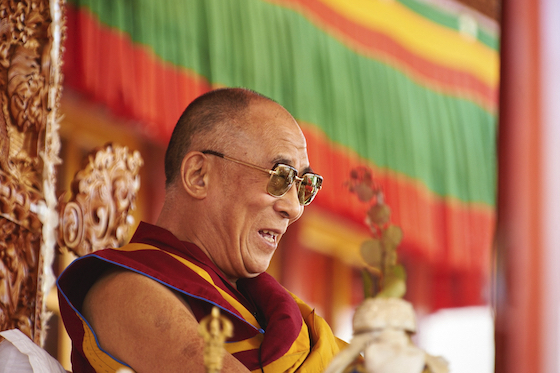
Portrait of His Holiness the Dalai Lama by Olivier Adam
The Dalai Lamas are considered manifestations of Avalokiteshvara or Chenrezig, the Bodhisattva of Compassion and the patron saint of Tibet. Bodhisattvas are enlightened beings who have chosen to be continuously reborn to end the suffering of sentient beings.
The current Dalai Lama, Tenzin Gyatso, is the 14th reincarnation. He was born in 1935, two years after the death of the 13th Dalai Lama. His Holiness the 14th Dalai Lama encourages non-sectarianism.
The central teachings of the Gelug School are the lamrim (stages of the path to enlightenment) teachings of Tsongkhapa, based on the teachings of the 11th-century Indian master Atisha.
Nunneries Supported by the Tibetan Nuns Project
The Tibetan Nuns Project began in 1987 in the Dharamsala area, home of His Holiness the Dalai Lama and a large number of Tibetan refugees.
We initially reached out to assist the nearby nunneries, Geden Choeling and Tilokpur. In response to a large influx of refugee nuns escaping from Tibet, the Tibetan Nuns Project built two new nunneries, Dolma Ling and Shugsep.
Currently, the Tibetan Nuns Project supports these 7 nunneries in northern India:
- Dolma Ling Nunnery and Institute, non-sectarian,
- Shugsep Nunnery and Institute, Nyingma
- Geden Choeling Nunnery, Gelugpa
- Tilokpur Nunnery, Kagyu
- Sherab Choeling Nunnery, non-sectarian
- Sakya College for Nuns, Sakya
- Dorjee Zong Nunnery, Gelugpa
